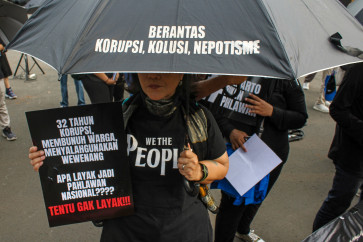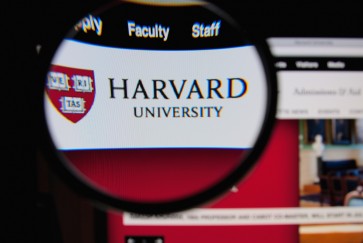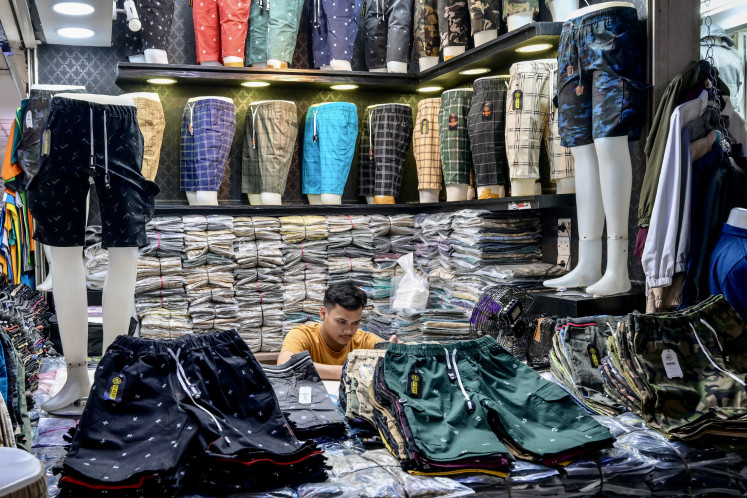Aceh and Nias' road to recovery
It's been four years since tragedy struck Aceh and Nias killing hundreds of thousands of people and causing unprecedented damage to the their economy and the community's social structure
Change text size
Gift Premium Articles
to Anyone

I
t's been four years since tragedy struck Aceh and Nias killing hundreds of thousands of people and causing unprecedented damage to the their economy and the community's social structure.
Three months after the deadly earthquake and tsunami hit Aceh and Nias, a second earthquake hit Nias.
The first earthquake in December 2004, declared the second largest earthquake the world had experienced in a generation, and ensuring tsunami decimated Aceh, which had been ravaged by three decades of armed conflict. Thousands of houses, agricultural land and infrastructure like roads, airport strips, health and religious facilities and schools were destroyed.
Therefore, rehabilitation and reconstruction of the affected areas was a critical and challenging issue to be addressed as the survivors, like everyone else on the planet, have the right to lead normal lives. Given the enormity of the damage, it was hard for the Government of Indonesia to tackle it by itself as huge funds, resources, expertise, know-how and disaster-management experience were urgently needed.
Thanks to the collective efforts of the Indonesian government, with Badan Rehabilitasi dan Rekonstruksi (BRR) or the Rehabilitation and Reconstruction Agency for Aceh-Nias as the lead coordinator, international and national NGOs, and bi- and multi-lateral organizations, rehabilitation and reconstruction projects could be effectively carried out despite the arduous challenges facing them in the field.
Four years since the rehabilitation and reconstruction work began, substantial progress and achievements have been made that enable the people of Aceh and Nias to live relatively better now that the many houses destroyed in the natural disaster have been rebuilt. Other aspects related to community life, such as agricultural land and seaports that support people's livelihoods, airports/airstrips, schools, clinics and religious facilities have also been rehabilitated and reconstructed.
Agricultural land has even been increased, as have the number of seaports. So, it is no exaggeration to say that the tragic and surreal sights of Aceh and Nias four years back have faded away and have been replaced with new houses, buildings, roads, ports and other public facilities, with locals, especially farmers, back in their fields and fishermen back at rivers and sea.
BRR data show that up to the end of December 2008, 103,341 hectares of land have been rehabilitated to replace the damaged 60,000 ha. The 14 seaports in Aceh that were damaged in the tsunami have been replaced with 20 new seaports.
The data also show that the number of teachers has also increased to 38,081 from the previous 2,500 that were killed in the tsunami. Meanwhile, health clinics have also increased to 1,016 from the previous 127, and religious centers to 3,192 from the previous 3,183.
The concerted efforts involving individuals from all corners of the globe are well worth recording as they have contributed to the progress and achievements that benefit the people of Aceh and Nias. After four years of rehabilitation and reconstruction work, several international organizations have shifted their policies.
The World Bank, for instance, has shifted from emergency reconstruction to ensuring sustainability of reconstruction investments and promoting economic development. "In order to ensure sustainability, the MDF prioritized its efforts in two areas during 2008. Besides supporting the transition from BRR to local government, we will also enhance the long-term economic development of Aceh and Nias," said World Bank Country Director Joachim von Amsberg.
Von Amsberg said the Multi-Donor Trust Fund (MDF), established by a group of international donors in response to the Government of Indonesia's request for coordination and support for the reconstruction and rehabilitation of Aceh and Nias, has been extended to December 2012 to ensure implementation continues to meet critical needs of construction. "The extension allows the Multi-Donor Fund to ensure that the recovery is institutionally, financially and socially sustainable and continues to play a critical, multi-faced role in the recovery of Aceh and Nias," he said.
To ensure that the money is translated into projects in a responsible and transparent manner, the World Bank supervises the projects by overseeing the procurement of large projects. "We have the responsibility of ensuring that money allocated by MDF is translated into projects," he said.
Like the World Bank, UNDP has also shifted its priorities. In the early phase of recovery, UNDP focused on helping more than 40,000 households and families to restart their businesses, engage in productive activities and rebuild their communities, "This included rebuilding 34,000 houses in cooperation with UN-Habitat," said El-Mostafa Benlamlih, United Nations Development Program (UNDP) Resident Representative/UN Resident and Humanitarian Coordination in Indonesia.
UNDP also boasted of turning cleaning up tsunami debris into an income-generating program. "What began as a short-term tsunami debris-clearance operation became a program that provided valuable sources income for tsunami survivors," he said, adding that it offered training and employment to hundreds of individuals at a furniture workshop for offices, houses and schools.
The program helped to increase 120 small and medium enterprises skilled in areas such as recycling and also helped more than 1,300 farmers return to rehabilitated agricultural land that was damaged in the tsunami.
The Asian Development Bank (ADB) is another international donor that has contributed considerably to the rehabilitation and reconstruction of Aceh and Nias. Its multi-sector tsunami assistance package in Indonesia covers agriculture, fishery, irrigation, micro and small enterprise development, housing, water and sanitation, health, education, transportation, power, spatial planning and environmental management, and fiduciary.
According to Pieter Smidt, head of ADB's Extended Mission Sumatra, implementation of the Earthquake and Tsunami Emergency Support Project (ETESP) -- a US$294.5 million multi-sector project with 12 components -- has been a challenge. "However, 85 percent was complete by the end of December and will be fully completed by the end of 2009," he said, adding that ADB focused on people's livelihoods, with an investment of $107 million.
"More importantly, significant impacts are visible in the affected rural coastal areas," he added.
Smidt noted, "Towards the end of this year, ADB's direct support to Aceh and Nias will be scaled down following the completion of ADB's support for the reconstruction program."
"Support for the longer term development of Aceh and Nias might be discussed between ADB and the government during discussions within the framework of the formulation of the new Country Partnership and Strategy," he said.
Von Amsberg, Benlamlih and Smidt praised the Government of Indonesia for setting up BRR which, according to them, boosted foreign confidence in the country.
"BRR brought transparency, accountability and professionalism away from political and bureaucratic labyrinths. This was needed to establish confidence in the mechanism," Benlamlih pointed out.
BRR, which is set to wind up its mission overseeing local and international aid efforts in April, has been praised for getting the job done without the corruption that routinely afflicts Indonesian government projects. The agency was founded through Government Regulation in Lieu of Law No. 10/2005 to coordinate and implement the $7.2 billion reconstruction effort of the Indonesian government.
In reference to its anti-corruption unit, BRR director Kuntoro Mangkusubroto said in a workshop in Jakarta recently that convincing foreign donors that their pledges would be safe was a big challenge given the country's corrupt environment. Therefore, building a system that prevented staff from conducting corrupt practices was of importance. Besides setting up an internal anti-corruption unit (SAK), BRR also uses credible auditor Earns & Young to make accountable reports through the use of information technology.
Projects are tendered transparently instead of being awarded through collusion, nepotism and corruption (KKN), which are still rife in the country.
The efforts have paid off. "Out of the pledged $7.2 billion, $6.2 billion has been disbursed and translated into projects," Kuntoro pointed out.
Another positive side to the corruption-free BRR is the improvement of Indonesia's position on the corruption index. "The country's position on the corruption index dropped to 126 in 2008 from 133 in 2004. This is something we are proud of," he said.
Lessons learned
While the devastating and sudden attack of earthquake and tsunami brought the international community to Aceh for humanitarian purposes, the four years of rehabilitation and reconstruction projects have provided lessons that Indonesians, and perhaps people from other developing countries, can learn, especially when dealing with projects.
There are always unscrupulous elements when it comes to projects, tempting individuals to engage in graft, misappropriation of funds or unfair practices to win a bid for a project or a contract. "Some individuals engaged in unscrupulous practices, such as someone who abandoned a housing project before the project was complete was reported to the police and taken to court," a BRR spokesman said.
"One of the lessons learned concerned the establishment of BRR with a strong leadership. With a strong leadership, MDF supports the agency in regards to the rehabilitation and reconstruction projects," the World Bank country director said.
National Development Planning Board (Bappenas) chairman Paskah Suzetta said the tsunami created a high sense of solidarity among people, both at the national and international level, to undertake rehabilitation and reconstruction work. "On top of that, it is also important to learn how to rehabilitate and reconstruct areas hit by massive, large-scale natural disasters. In this regard, the government has set a policy on how to tackle and minimize the risk of disaster in a structured and systematic way," he said.
Smidt said that a noteworthy aspect of the ETESP experience is that "it has shown that delivering a large post-disaster reconstruction program through the government's on-budget system is possible provided the right and flexible delivery arrangements are put in place -- both on the Government of Indonesia's side and the donors' side."
As BRR will be disbanded in April 2009, BRR will transfer the tasks and work to manage the assets built through rehabilitation and reconstruction to the local government. The facilities or assets will serve as precious capital for local people to start a new life for a better future.
One thing is for sure, as Kuntoro once said, "The tsunami was a contributing factor to the peace agreement, ending some 30 years of conflict and opening a new chapter for the people of Aceh. The earthquake also ended Nias' isolation and provided the opportunity for more development and interaction, in particular with other parts of North Sumatra and Aceh." -JP/Sudibyo M. Wiradji









